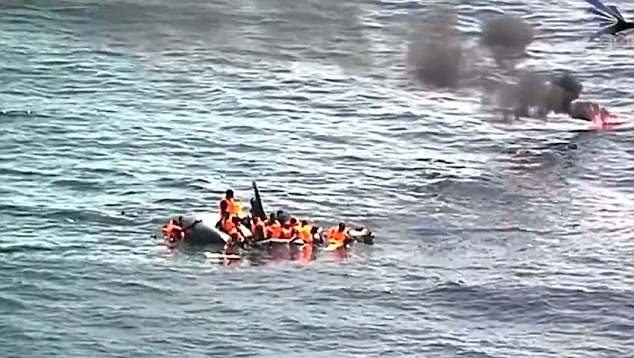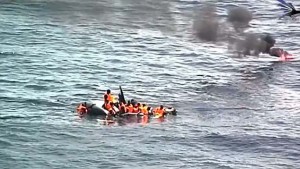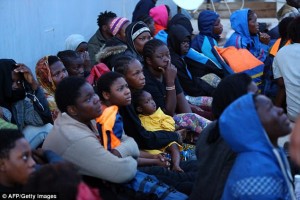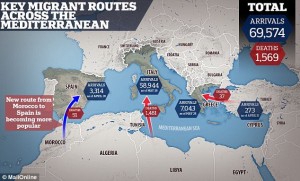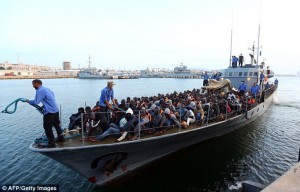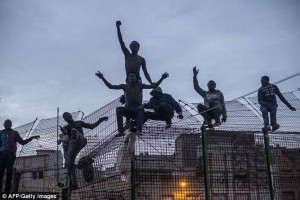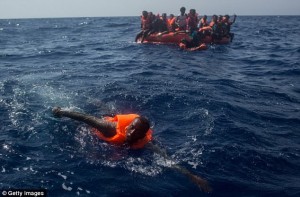Daily Mail
By Julian Robinson for MailOnline
Migrants’ new route to Europe: Number of refugees using perilous crossing from Morocco to Spain TRIPLES in a year as other routes are shut down.
The number of migrants using a perilous new sea route across the Mediterranean from Morocco to Spain has more than tripled in a year, it has emerged.
- Number of migrants crossing from Morocco to Spain has tripled in the last year
- More than 3,300 refugees made perilous journey in first four months of 2017
- It comes after EU and Turkey struck a deal to curb flow of migrants into Greece
- Tens of thousands still use another crossing between Libya and southern Italy
More than 3,300 refugees crossed to Europe from the North African country in the first four months of this year – compared to just over a thousand in the same period in 2016.
The surge in boat arrivals on the so-called Western Mediterranean route has prompted a series of rescue missions in recent weeks, including 34 refugees saved from a burning dinghy near an island between the two countries.
It comes amid a dramatic reduction in refugees crossing between Turkey and Greece in the wake of a deal struck between the EU and Ankara last year.
The number of migrants using a perilous new sea route across the Mediterranean from Morocco to Spain has more than tripled in a year, it has emerged. Just days ago dozens were rescued from a burning dinghy near the Spanish island of Alboran, between the two countries.
More than 3,300 refugees crossed to Europe from the North African country in the first four months of this year – compared to just over a thousand in the same period in 2016. Migrants are pictured after being rescued near Libya last week.
However, an established route between war-torn Libya and southern Italy still accounts for the majority of sea crossings with more than 58,000 making the dangerous journey in the first five months of this year.
There have been more than 69,000 arrivals by sea so far this year with nearly 1,700 deaths. In the same period last year, 198,346 had arrived while 2,267 had been killed making the journey.
The crossing to Spain has accounted for 51 deaths so far this year – more than the Eastern Mediterranean Route from Turkey to Greece which, in the same period in 2016, saw 376 deaths.
The increase in numbers on the Spain to Morocco route comes after the European Union struck a deal with Ankara to stem the flow of migrants crossing from Turkey to Greece.
Following the agreement, just 7,043 made that crossing in the first five months of 2017 – compared to 156,267 in the same period last year.
While the figures, from the UN’s International Organisation for Migration, relate to sea crossings, many more refugees last year crossed into Europe by land from Turkey.
An established route between war-torn Libya and southern Italy still accounts for the majority of sea crossings with more than 58,000 making the dangerous journey in the first five months of this year. Refugees are pictured after being rescued by the Libyan coastguard last week.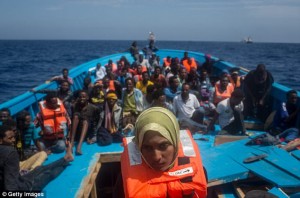
There have been more than 69,000 arrivals by sea so far this year with nearly 1,700 deaths. In the same period last year, 198,346 had arrived while 2,267 had been killed making the journey
On Sunday, more than 30 migrants were rescued off the coast of Spain after their rubber speed boat caught fire, forcing them into the water in a dramatic moment caught on camera.
The video tweeted by EU border agency Frontex shows the 34 migrants travelling on board a black boat Sunday when flames suddenly erupted at the back near the engine, and rapidly spread through the small vessel.
The migrants, most of whom appeared to be wearing life jackets, jumped into the water according to images caught on camera by a Portuguese air force plane helping Frontex with maritime surveillance, which threw them a small lifeboat and notified Spanish coastguards.
Some were able to scramble onto the lifeboat while others held onto their sinking vessel, the coastguards said in a statement.
A helicopter and several boats were dispatched to the area southwest of Alboran Island between Morocco and Spain.
Tomas Garcia, a manager at the coastguard centre in Spain’s southeastern Almeria province who has 24 years experience coordinating rescues was quoted as saying in the statement that this ‘was one of the most complex’ his centre had seen.
A fisherman sailing in the area also helped in rescue efforts.
Earlier this month, about 100 African migrants stormed over a high double fence between Morocco and the Spanish enclave of Melilla in a violent assault that left three police officers injured, officials said. Refugees are pictured attempting to cross the fence in 2014.
The migrants, whose nationalities were not disclosed, were finally taken safe and sound to the port of Motril in southern Spain.
Last week, Spain’s maritime rescue service saved 157 migrants from five small boats attempting to cross the Mediterranean.
The service completed five different rescue missions in waters east of the Strait of Gibraltar to reach the small craft from late Friday through until Saturday evening.
The service said that it reached the first boat carrying 27 men and six women late on Friday after it was sighted by a Spanish military plane. Another rescue boat intervened early Saturday to pull five men from a second boat.
A third craft in danger of sinking with 35 men aboard was then spotted by a Spanish navy outpost on the Alboran Island between Spain and Morocco. The Spanish military helped the boat dock on the island, where the migrants were picked up by the rescue service.
A fourth boat with 30 men and two women was located after the service received an alert from Moroccan authorities. The fifth boat bearing 42 men and 10 women was spotted by a Spanish navy vessel, which guided the rescue service to its whereabouts.
Earlier this month, about 100 African migrants stormed over a high double fence between Morocco and the Spanish enclave of Melilla in a violent assault that left three police officers injured, officials said.
A man swims from a life raft to a rescue vessel after a wooden boat bound for Italy carrying more than 500 people capsized on May 24 off Lampedusa, Italy.
Around 300 sub-Saharan African migrants attempted to force their way across the fence at about 7am in a coordinated operation, a Spanish police spokesman said.
‘Around 100 managed to enter Melilla,’ he told AFP.
The barrier is composed of two 20ft-high fences, with criss-crossing steel cables in between. In order to get across, migrants often use hooks and shoes studded with nails.
Three policemen were injured in clashes with the migrants, who kicked and threw rocks at the officers, Spain’s interior ministry said in a statement. One of the officers was injured in the hand by one of the hooks used by migrants and several police vehicles were damaged, it added.
Three migrants suffered bruises and small cuts in the attempt to cross the border, said a Red cross spokesman in Melilla.
Melilla and Ceuta, another Spanish enclave nearly 250 miles away on the north coast of Africa, are often used as entry points into Europe for African migrants.
They have the only two land borders between Africa and the European Union.
Thousands of migrants have attempted to cross the 7.5 mile frontier between Melilla and Morocco, or the five-mile border at Ceuta, by climbing the border fences, swimming along the coast or hiding in vehicles.
In February around 850 migrants managed to storm across the border into Ceuta over four days.
Spain announced in March that it would nearly double the capacity of its migrant reception centres in the two territories to 8,500 places from 4,500.
Spain has drawn criticism from human rights groups for allowing some migrants to be immediately turned back to Morocco in such incidents.
They argue that skipping the lengthier deportation procedures deprives people of the opportunity to claim asylum.




